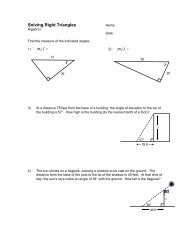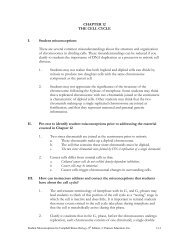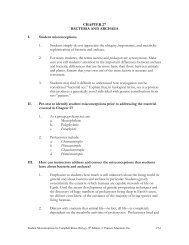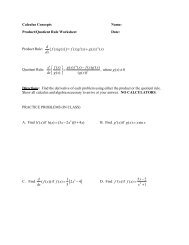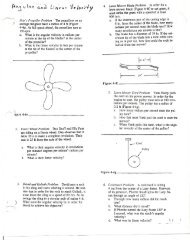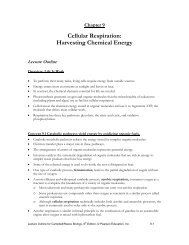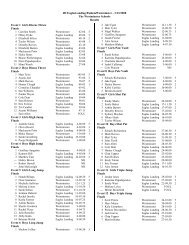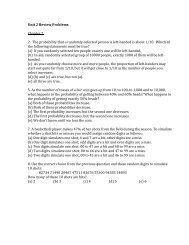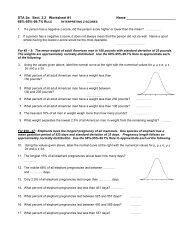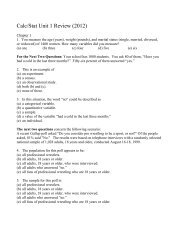CHAPTER 14 MENDEL AND THE GENE IDEA - Hancock High School
CHAPTER 14 MENDEL AND THE GENE IDEA - Hancock High School
CHAPTER 14 MENDEL AND THE GENE IDEA - Hancock High School
Create successful ePaper yourself
Turn your PDF publications into a flip-book with our unique Google optimized e-Paper software.
o Geneticists disagree about the extent to which human consanguinity increases the risk of<br />
inherited diseases.<br />
Most societies and cultures have laws or taboos forbidding marriages between close relatives.<br />
Cystic Fibrosis<br />
Cystic fibrosis strikes one of every 2,500 whites of European descent.<br />
o One in 25 people (4%) of European descent is a carrier for this condition.<br />
o The normal allele at this gene codes for a membrane protein that transports chloride<br />
between cells and extracellular fluid.<br />
o If these channels are defective or absent, abnormally high extracellular levels of chloride<br />
accumulate.<br />
o Then the mucous coats of certain cells become thicker and stickier than normal.<br />
o This mucous buildup in the pancreas, lungs, digestive tract, and elsewhere causes poor<br />
absorption of nutrients, chronic bronchitis, and bacterial infections.<br />
o The extracellular chloride also contributes to infection by disabling a natural antibiotic made<br />
by some body cells.<br />
Without treatment, affected children die before age 5, but with treatment, they can live past their<br />
late 20s or even 30s.<br />
Sickle-Cell Disease<br />
The most common inherited disease among people of African descent is sickle-cell disease,<br />
which affects one of 400 African-Americans.<br />
o Sickle-cell disease is caused by the substitution of a single amino acid in hemoglobin.<br />
o When oxygen levels in the blood of an affected individual are low, sickle-cell hemoglobin<br />
aggregates into long rods that deform red blood cells into a sickle shape.<br />
o This sickling creates a cascade of symptoms, demonstrating the pleiotropic effects of this<br />
allele, as sickled cells clump and clog capillaries throughout the body.<br />
Doctors can use regular blood transfusions to prevent brain damage and new drugs to prevent or<br />
treat other problems.<br />
At the organismal level, the nonsickle allele is incompletely dominant to the sickle-cell allele.<br />
o Carriers are said to have sickle-cell trait.<br />
o These individuals are usually healthy, although some may suffer symptoms of sickle-cell<br />
disease under blood-oxygen stress.<br />
At the molecular level, the two alleles are codominant because both normal and abnormal<br />
(sickle-cell) hemoglobin molecules are synthesized.<br />
About one in ten African-Americans has sickle-cell trait.<br />
o The high frequency of heterozygotes is unusual for an allele with severe detrimental effects<br />
in homozygotes.<br />
Individuals with one sickle-cell allele have increased resistance to the malaria parasite, which<br />
spends part of its life cycle in red blood cells.<br />
o In tropical Africa, where malaria is common, the sickle-cell allele is both a boon and a bane.<br />
○ Homozygous normal individuals die of malaria and homozygous recessive individuals die of<br />
sickle-cell disease, while carriers are relatively free of both.<br />
Lecture Outline for Campbell/Reece Biology, 8 th Edition, © Pearson Education, Inc. <strong>14</strong>-13




